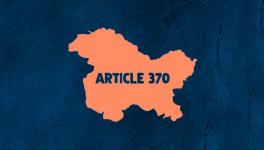Why Sikkim’s Constitutional Position is ‘Special’

Image Courtesy: The Hans India
With Articles 370’s abrogation, there have been apprehensions that similar steps may be taken in the Northeast with regard to the special provisions that several states have been granted. However, the only three states in the Northeast with extensive special provisions are Nagaland (371A), Sikkim (371F) and Mizoram (371G). Though all three were granted these special provisions on the basis of political agreements and promises, Sikkim’s special provision bears a striking resemblance to that of Jammu and Kashmir to the extent that the political agreements and promises were between two sovereign entities.
The Instrument of Accession signed by the King of Jammu and Kashmir Hari Singh handed over power to the Dominion of India with regard to defence, external affairs, communications, elections and the judiciary. The conditions laid down in the agreement were that the Dominion Legislature would not have power to legislate over land in Jammu and Kashmir. Neither did the Instrument of Accession create any obligation on the part of the King to accept a ‘future’ Constitution of India. The agreement also retained sovereignty in the monarch. Hence, the introduction of Article 370 of the Constitution also made a reference to the Instrument of Accession to the extent that Parliament’s legislative powers were limited to matters contained in the Instrument of Accession.
In Sikkim’s case, there was no Instrument of Accession solely because the Chogyal refused to sign one. This then makes Sikkim’s merger and relationship with India more complicated. One example of this is that the State Bank of Sikkim does not fall under the jurisdiction of the Reserve Bank of India (RBI). Instead it performs a similar function to the RBI of being a lender to the government. However, the State Bank of Sikkim also functions as a commercial bank.
Also read: Article 370: Apprehensions That NE Will be Next
Prior to the merger of Sikkim, India and Sikkim’s relationship was governed by the Indo-Sikkim Treaty of 1950. Since it is an accepted position in international law that only sovereign entities can enter into treaties, Sikkim’s status at the time may be construed accordingly. The treaty, however, relegated Sikkim to being a protectorate and surrendered power over defence and external affairs to India. Being a protectorate was grudgingly accepted in Sikkim as is evident from an August 2, 1969, report in the Economic and Political Weekly. According to the report, the Chogyal was preparing to visit New Delhi to review the treaty. The report also mentioned that “Sikkimese youth were, after all, the first in the Himalayan belt to have started an organised anti-Indian demonstration on August 15 last year.”
GBS Sidhu in his book on Sikkim’s merger mentioned that the Indian intelligence agencies’ role in Sikkim began only in 1973. Hence, the political developments that took place then leading up to the merger may have had a heavier imprint from India. The tripartite 8th May Agreement between the Chogyal, the Sikkimese political parties and the Government of India laid down the general spirit of how the administration of Sikkim was to be run. This was later given teeth through the Government of Sikkim Act, 1974.
The Act functioned a Constitution of sorts as it laid down the powers and functions of the executive and legislature. It also provided for elections. One notable feature was that the Act stated that “no single section of the population is allowed to acquire a dominating position in the affairs of Sikkim mainly by reason of ethnic origin”. This feature has been written into Article 371F in spirit though clauses (f) and (g).
However, the clause in Article 371F, which may indicate what Sikkim’s status would be if the Article is abrogated or repealed is clause (m), that bars all courts from hearing any dispute arising out of any pre-merger “treaty, agreement, engagement or other similar instrument relating to Sikkim”. The words used in this clause may be construed as having accepted Sikkim’s previous international legal status.
Hence, in the absence of an Instrument of Accession, coupled with the fact that Sikkim and India had a relationship governed by a treaty, the abrogation of Article 371F would in law revert Sikkim back to its status as a protectorate. Such a situation is not possible if 371A or 371G are abrogated as these provisions are the result of negotiations between the Government of India and the armed political groups in Nagaland and Mizoram, respectively. There are no legal documents to prove that either of the two places had a sovereign or even protectorate status at any point of time. Hence, abrogating those two provisions would likely result in civil unrest, however, it would have no impact on their legal status.
Also read: How Sikkim Became the 22nd State of India
Get the latest reports & analysis with people's perspective on Protests, movements & deep analytical videos, discussions of the current affairs in your Telegram app. Subscribe to NewsClick's Telegram channel & get Real-Time updates on stories, as they get published on our website.
























